Our fall chicken harvest (Boo! Contains real life farm-to-table images)
On a cool, cloudy day last week, we harvested our six hens. They went from blessing us with six brown eggs a day to stocking our chest freezer with four quarts of nourishing chicken-vegetable soup and ten jars of beautiful, clear stock.
No, we don’t just keep hens as pets; yes, we use them to their full potential. This post details why and how we harvest our own birds and what works for us in a descriptive, not prescriptive way. This is not a comprehensive tutorial or chicken butchering 101, but a look at our simple cull, by request from readers and followers on Facebook and Instagram.
When I saw that this post would fall on October 31 in the editorial calendar, I thought, “What better day to share a photo essay of chicken butchering than on Halloween?” There certainly are plenty of gory posts are floating around with edible eyeballs, worms, and the like, although this is probably one of the few with actual entrails to be found.
That said, I think the images honor the chickens. And it’s not really that gross; it’s just the prequel to your classic chicken dinner. And it’s probably one of the nicer prequels, if you know what I mean: fresh air, fall leaves, scrubbed stock pots, and a bright orange apron.
Photos begin after the jump.
See our small coop? As Danny shared in our journey to backyard chickens, it is a three-season coop, and we don’t winter the chickens. The shelter is not wired for heat or light, two elements the hens would need to survive our Canadian winter. We’ve always planed to harvest our hens in the fall, before the temperature drops too much.
Danny and a friend, Duy (who’s here to learn some basic skills), catch the chickens by the legs. It doesn’t hurt them, and they are easily transported without struggle.
Danny thanks the hens for providing us with food. They’ve led a good life. They will continue to nourish us, just in a different way. We are teaching our children where meat comes from and making the connection between farm and fork.
The nitty-gritty. You can shape a holding funnel from tin or sheet metal, but Danny just cut the top off of an old traffic cone we had in the shed, nailed it to a tree and voila. This is an old farm trick that is fast and simple; the cone contains the bird until the flapping stops and the blood is drained. No chickens running around with their heads cut off on our lawn if we can avoid it – Halloween or not.
Do I need to explain more? I think not.*shudder*. Although I have done this part, I much prefer to step in just afterward.
I’ve done enough butchery in restaurants and on farms as a kid to be able to matter-of-factly take my butcher’s knife to the chickens once Danny brings them over to my outdoor ‘station’.
I’ve got a simple set up:
- a beat-up tin bucket for feathers, feet, viscera and the like
- a large cutting board
- a Mac butcher’s knife
- a large stock pot filled with cold water for cooling down the carcasses
- rubber gloves
Our hens are layers, which means they don’t have much meat on their bones since their energy has been focused on laying eggs. They are also semi-free range, and this activity toughens the meat. That’s okay; they gave us terrific eggs, it just means that they will not be suitable for roasting.
Since the hens are intended only for chicken stock and soup, I don’t need to pluck them (the tedious process of removing the feathers and pinfeathers). By skinning them, I can remove the feathers in under two minutes, leaving all the meat intact. This is what I do.
I remove the feet by cutting through the leg, just below the hock joint. I slit the skin open down the breast bone and peel it back. It requires a little loosening around the legs and back, but for the most part, it peels right off in a feathery cape, leaving a very skinny chicken indeed.
Eviscerating is next, or removal of the internal organs. This was always my job when we were growing up, and has always held a strange fascination for me. Especially those partially-formed eggs.
See what I mean by a skinny bird? Those boneless, skinless chicken breasts are only about 1/2 inch thick. Here I open the body cavity and remove the entrails, keeping the heart and gizzard for stock.
I also keep the perfectly formed eggs with their soft, papery shells that I find inside the bird. These are very nutritious and I use them for baking – opening them with scissors as there is no hard shell to crack.
Where are the children? Noah and Mateo opted out of the butchering this year, but fully understand what is going down today. They skipped out to say goodbye to the hens (and Noah shed a few tears), then settled onto the sofa with the cats for some Netflix.
While we work, Clara has her afternoon nap, and a friend hangs out in the house to keep an eye on everyone.
Six hens are harvested, then the empty coop is cleaned and stored for the winter. Danny takes care of this part, shoveling most of the nitrate-rich manure onto our compost. His boss has requested a bag for his garden, so Danny fills a sack, and plenty of jokes fly about giving the boss crap on Monday.
My work is done in under half an hour. Old school knife skills collide with modern day technology as I take time to Instagram a a few egg yolks I left in a carcass. It turns out pretty well and garners a slew of comments such as “Cool!”, “Wow!” and my favorite, “whuuuuuuut.”.
Yes, these healthy layers have dozens of eggs inside them, all in various stages of development, from tiny caviar-like clusters, to the fully formed, soft-shelled egg pictured above. If you’ve ever wondered where the egg comes from…well, now you know.
The cleaned chickens are thoroughly washed and are ready for the stock pot. Danny finishes cleaning up my outdoor station and I head for the kitchen.
On the way, I stop by the garden to gather a big bunch of Italian parsley for the stock. It feels really, really good to be raising even a smidgen of our own food.
Disclaimer: This post is meant to be descriptive, not prescriptive. This method works well for us, but we are not proclaiming that this is the singular best way to butcher chickens. Please check your state or province regulations on animal slaughter for human consumption. Thanks!
Thanks. To my friend Melissa for shooting the chicken harvest project and for not being squeamish. Not once.
Are you interested in chicken farming?

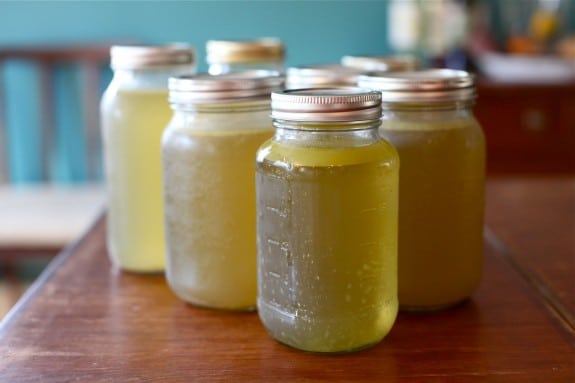
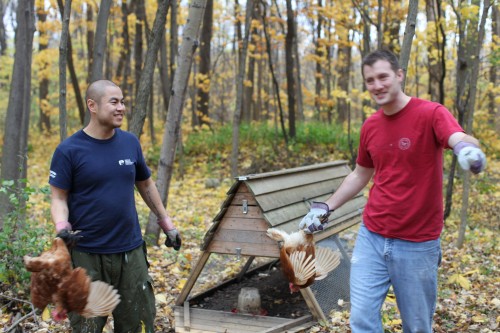
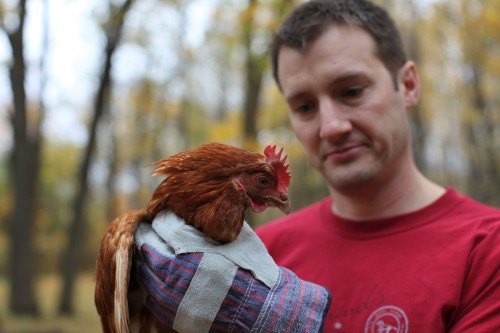
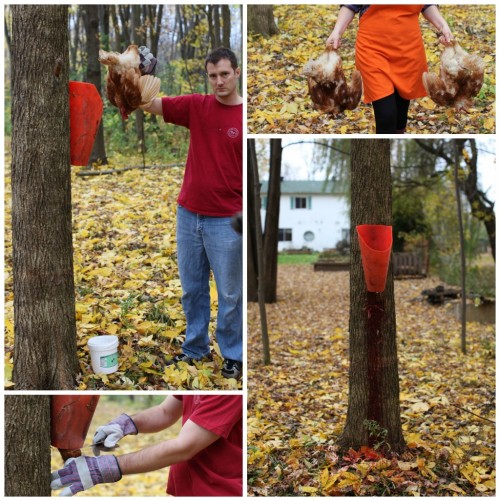
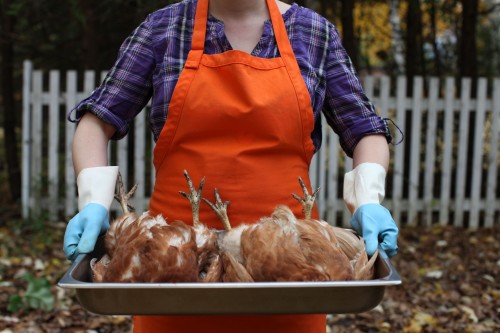
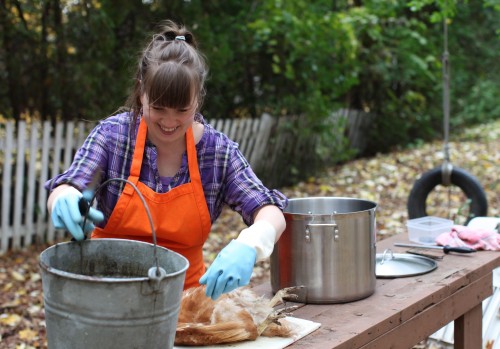
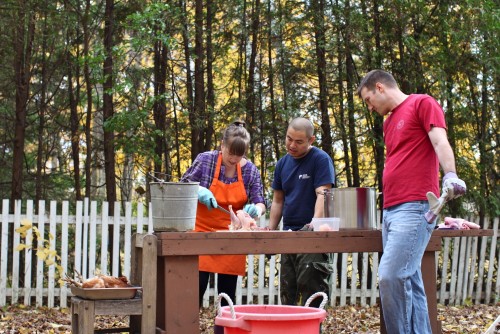
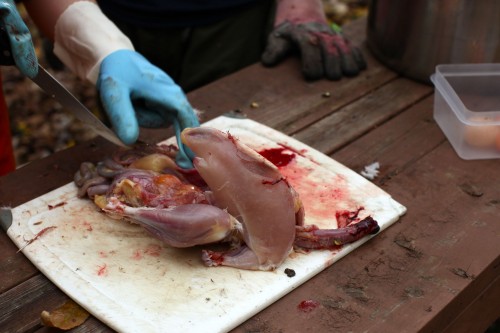
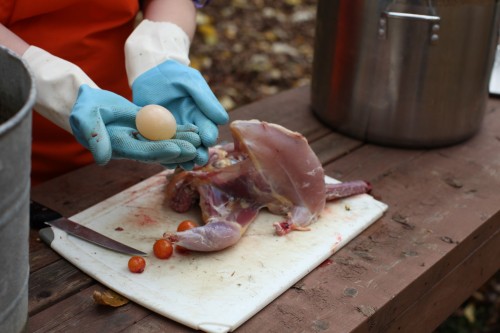

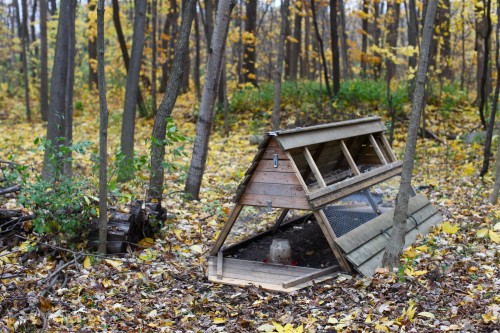
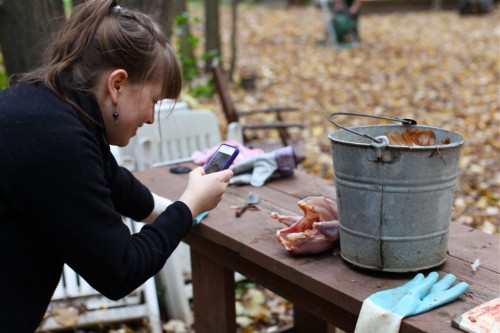
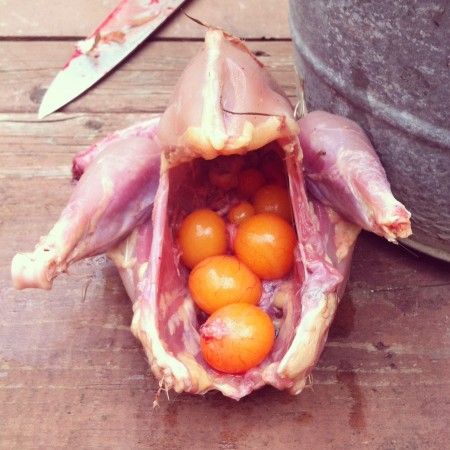
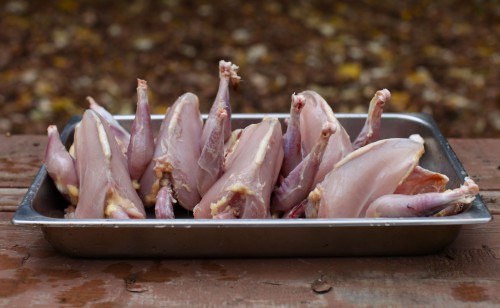
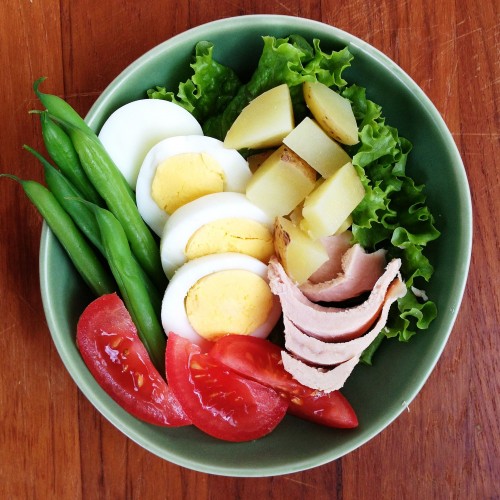
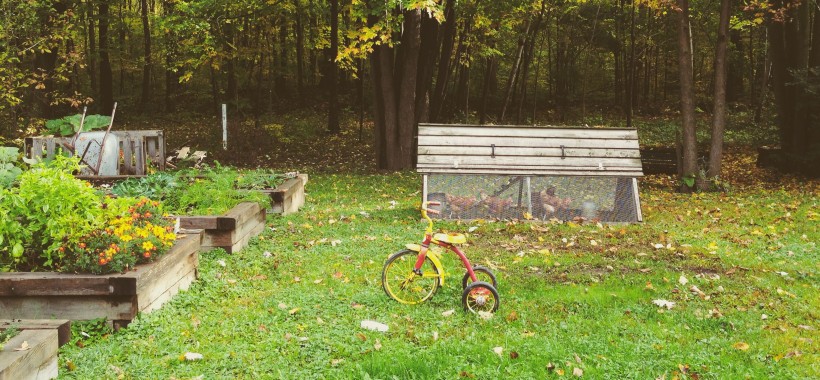
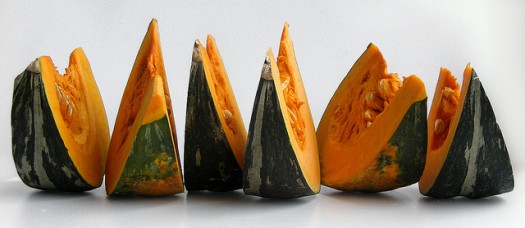
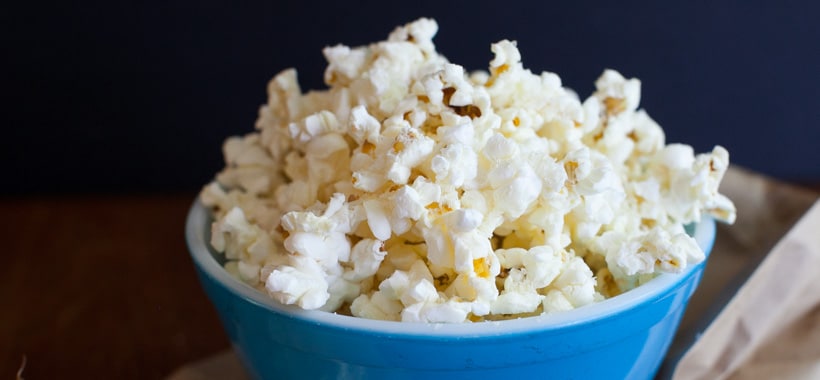
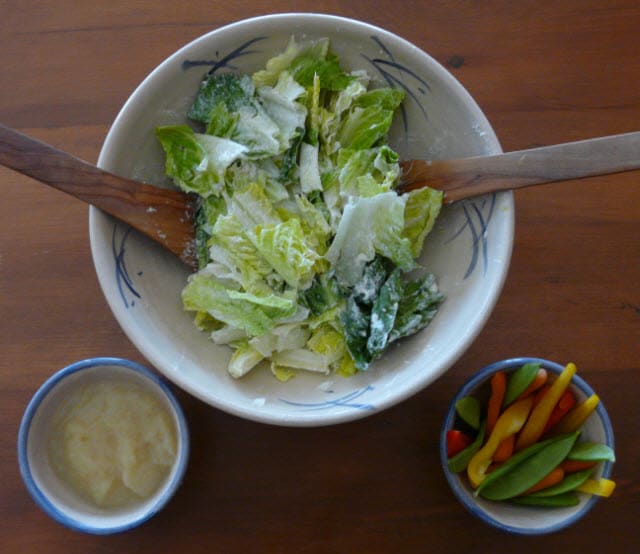
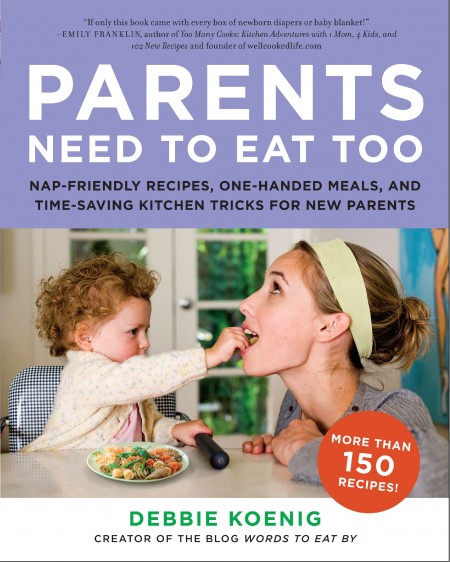
Thanks for this real life post!
You’re welcome, Julia. Thanks for your comment and support.
Chicken harvesting was a part of my childhood. We loved having chickens, and it was good to also be matter-of-fact about the reality of eating meat. As kids, we loved the whole “headless chicken dance”– what could be more thrilling?– but I like this method you guys used. I appreciate this post, it’s good to be honest about harvesting animals for food.
I think when our children are a little older (and can understand the natural reasons behind it) we’ll show them the ‘dance’ you spoke of above. 🙂 Thanks for your comment and support!
Very interesting real life post. But I don’t think I will ever have the nerve to do the butchery myself 🙂
Wow, that was an education. I think it’s so important to know where our food comes from. We grow lots in our yard, and had pondered chickens, but it’s the slaughter that intimidates us. Especially the attachment we would expect our kids to get to the birds. This post has given me way more information to work with for that decision!
Good on you for reading through. Yes, it’s an eye opener, for sure. Remember you can always take your animals to an abattoir and pick them up later, all nicely vacuum packed.
We expected our children to become attached to the hens, but they never really did.
Good luck with your decision and thanks for your comment and support.
This is so neat! I thought I would be all “NEVER MEAT AGAIN” after reading this post, but I now think it should be required reading for anybody who eats meat! I have always just glossed over where meat comes from even though I am careful about where everything else comes from (Vegetables from Guatemala in a Maine grocery store? Those can’t be fresh…). Obviously meat in the store didn’t come from a small homestead, but it is cool to see the process and have an idea of what it would be like to do it myself. Thanks!
I’m so glad this didn’t turn you off meat, Lauren. Thanks for your comment and support!!
My husband really wants to raise chickens. This is a wonderful, informative post. Thanks for sharing some of the reality of it. I don’t have the butchering skills that you have, but I did take anatomy in college so I’m familiar with skinning animals; I guess i could do this if I had to…
Do you do this every year? Will the chickens not survive the winter where you are?
Hi Colleen,
Thanks for reading! We have a three-season coop, and we don’t winter the chickens. The shelter is not wired for heat or light, two elements the hens would need to survive our Canadian winter. We’ve always planed to harvest our hens in the fall, before the temperature drops too much. This is our first fall to do so.
Thanks for this post! We process our own chickens, too. This is our 2nd year doing it, and we do a couple batches a year. We keep the cornish x, so it’s interesting to see the eggs inside the hens. We do have a lot of layers, too, so when we do process them it’ll be nice to already know about the eggs…I’m sure it would have been a strange surprise that we would have had to instantly Googled!
My husband does the neck slicing and I take out the innards. I was definitely squeamish at first, but got over it really quickly. And we do boil ours first and pluck. Last year the boys – I have 3 – got a little sad and didn’t really want to be a part of it. This year 2 of the 3 wanted to help and one actually did do the slicing hand-over-hand with my husband. 10 years ago, if you would have said I’d be a pseudo-farmer and me and my family would be processing chickens, I’d have laughed. It’s really a great feeling to responsibly raise your own food, process it and throw it in your freezer.
Thanks for your awesome comment, Erica. Sounds familiar! I’m glad to hear your kids warmed up to the idea. We’re not pushing them at all, but I would love if they participated next year. They certainly were very hand’s on for the care of the hens all summer long.
Wow! I love that you raise your own chickens. My in-laws have chickens and i am blessed with beautiful farm fresh eggs all the time. There is nothing better. Love all your pictures and description. Great post Aimee! Thanks for sharing. P.S. I have a noah too ; D Love that your boys were chillin’ on the couch while all the action was going on. I think a few of mine would do the same.
I agree that farm fresh eggs are the best! Homemade stock from those chickens is a close second, though. 🙂
Thanks for reading and for your kind comment. I certainly had some hesitation when writing it all up.
This was quite informative, if a little gross. I often think that if I had to kill my own meat, that I might not eat much meat (which sounds bad, since I know most animals bound for the grocery store gets treated much worse before/during slaughter). I did like how Danny said a little thank you before killing the hens.
Thanks for not minding a little gross on October 31. 🙂
first i think that you did an absolutely amazing thing by showing this to you children. it is very educational and just plain cool to see. on the other hand i am vegetarian. my kids and my husband eat meat and i gladly prepare it for them. the main reason that i don’t eat meat is that the idea of the animal being killed and all the blood and guts gross me out. i have never eaten a piece of meat and not thought about the animal being alive and having the same thing we have….blood, guts, bones and skin. so for you to show this to your kids is a great thing because they will never have to think the way i think. the more things like this they see the less weird it seems. i wonder if i was exposed to seeing this as a child would i have never been a vegetarian.
It means so much to me that, as a vegetarian, you would still take the time to leave a thoughtful comment. Thank you! It certainly IS educational, and not anything that we should shy away from in front of our kids. Hopefully, we’re raising healthy eaters.
This is so interesting to see! My grand pa always ‘harvests’ his chicken when there are too many (he has a lot, like 20+ ). I never saw the process but asked for it before, now I’m sure I want to see it.
20! That’s a big job. You’ll have to help out next time. 😉
I’ve been interested in keeping backyard chickens, when I get a backyard. The fun part will be in convincing the man to do it. He is squeamish and likes to forget where his food comes from. But I think it would be a great lesson for him in showing appreciation for the animal that goes on to nourish us. Do you have any tips for finding the by-laws on backyard chickens in different municipalities?
We went to city hall for our information. Also asked the neighbors (one had chickens a few years back). Good luck convincing!
The eviscerating is what I am most concerned about with this whole process – as in I will totally screw it up 🙂 Thanks for the real life post though!
It’s honestly so easy. It’s impossible to screw up. Everything is in one tidy bundle, and slips right out. (yuk!)
You thank the chickens for feeding you? And what do they say, “oh, happy to oblige! This is the moment I’ve always dreamed of” how ridiculous. I definitely respect people who kill the animals themselves rather than leaving it to factory farms. And people around the world who have no other means of nutrition. But North Americans killing animals for chicken stock and a show of gratitude? This is ridiculous.
Sarah,
I’m not sure what else Aimee and her family would have done with layers that either (a) are at the end of their life anyway or (b) are too cost-prohibitive to keep through the winter. Would letting them freeze to death be more humane? Rotting in the back corner of the yard? Those options seem ridiculous to me.
I think using the resources available to its utmost is the way all humans should treat the earth and everything in it, whether a first or third world country. Thanking the chickens, thanking God for providing, thanking a wife for making amazing stock…all in the same basket of gratitude, a sorely underpracticed skill in these first world countries where we have an overabundance of “stuff,” if you ask me.
I do have a question for Aimee though – I’ve boiled up layers for stock before, and I always still use the meat in soups and casseroles. Do you still pick the cooked meat off the chicken? I’m also a little surprised there wasn’t more stock – do all 6 just go in your biggest pot together then? I’m fascinated…but kind of glad I live in the city where I can’t have chickens in my yard! 😉 Katie
Hi Katie, I used every bit of meat, although there wasn’t much and it was on the tough side. It made up the chicken soup mentioned at the top of the post, a very meaty soup base that I freeze and later add noodles or rice to.
There was more stock, but I used some right away. I also reduced a bunch of it down to a thick ‘demi glace’-like sauce for gravy. I freeze those in ice cube trays.
Good questions!
Manners are never ridiculous. Being grateful that we are able to proovide clean, nourishing food toour childeren is certainly not ridiculous. What’s ridiculous to me is ridiculing someone else. What Aimee and her family do with their livestock has little to no actual impact on you, and you certainly chose to read the entire post despite Aimee’s clear warnings about what it contained.
Aimee, thank you for this informative and interesting post. It is one of my dearest hopes to someday live in a home where I can keep chickens, but I also live in northern Canada and would have to deal with this exact situation. This gives me knowledge that will help me when that time comes.
I don’t think they’re ridiculous for doing this. I said I respect this way more than turning a blind eye to factory farming. The fact is very few north Americans need meat for nutrition. Its eaten for taste and enjoyment. We make justifications like “its the best to do without being vegetarian ” “God gave us dominion over animals ” or “come on, we said thank you! ” but in fact chickens are not gifts to us, they’re victims in the food chain. I find it ridiculous to thank them for dying to make our meals yummy, as if they’re happy to oblige.
I love this post. We have played with the chicken idea a bunch, but the winter is always what gets us. My aunt always butchered her birds in the fall, so it definitely is on my radar, but I just can’t commit. I keep hoping my neighbors will pull through and host the birds in their yard since everyone wants it to be a neighborhood activity.
I don’t think that I could ever butcher chickens, but thanks for the informative and interesting post. I think it is neat that you are doing that and educating your kids.
We are hoping to raise chickens starting next year or the year after but I wondered about the harvesting them part. Very interesting to learn that layers aren’t good for roasting. And really fascinating to see the eggs! Thanks for the informative post.
Thank you for sharing this post! I was fortunate as a child to watch the whole process, from my farmer grandfather butchering them (as a kid, the running around part was fascinating) to plucking them with my great-aunt. At that time, that’s where their food came from.
I know I wouldn’t be able to butcher chickens myself, but I think you’ve done it pretty humanely. I think for those of us who do eat some meat, it is good to do this at thoughtfully as possible. It looks like your chickens had a good life, and I was so interested to see the eggs inside; never seen that before.
Also very good to point out the differences between layers, free-range chickens, and the poor chickens raised in inhumane conditions with unnaturally large chicken breasts. Makes me more mindful of what I eat, and under what conditions this food was provided for me.
we no longer have egg layers nor poultry for meat. Your method is excellent and the ‘harvest’ was perfect. Great quality egg clusters and must admit that the skinning process was perfect for stock…my question however is what did you do with the meat? When I had laying hens which were utilized for stock I always skinned them, took out the unborn eggs and used them, boiled the hens and then took the meat and ‘stewed’ it into some really flavorful tomatoe sauce(lots of sauteed veggies and herbs into which I would put the meat which then ‘cooked’ again for about an hour)…it was then frozen to be used during the Winter…you guys are doing a wonderful job in home farming! We’re getting ready for our olive harvest. When I return home to ITALY from the STATES we’ll get on it! hey from the boot-shaped peninsula Paula
WOW. Just WOW.
Chicken, beef and pork butchering was all part of my childhood. I grew up on a farm where we raised the majority of our own food and Fall was always butchering time. My grandfather also had a smokehouse where a good portion of the pork was processed and cured. I’m always glad to see others who are keeping these skills alive. I think it’s important for children to understand that meat doesn’t originate at the grocery store.
I read through beginning to end, and while I have some interest but no immediate intent for raising my own chickens or harvesting them, it was very interesting to read. I appreciate that you warned us before the “jump” that there would be photos (none of which bothered me, and I can be squeamish). Our local high school FFA raises chickens and my nephew was involved with that when he was in school. They didn’t do the harvesting at school, but did go to the butcher to see it done. They both sell the chickens to local families and provide a BBQ chicken meal for the fall festival from what they raise. I hope that my daughters will participate when they are of age.
Thank you so much for your post. We moved to a rural farm from an urban city almost 4 years ago and have raised and butchered meat birds the last three years. We’ve also kept a flock of layers. They are such fun to have and the eggs are great!
We have three children (11, 9, and 7) and their responses have varied from 11 year old wanting nothing to do with butchering day (so she usually reads or plays with Grandma) to the 9 year old floating in and out and helping periodically to the 7 year old being fascinated with the biology and anatomy lesson that comes with eviscerating.
This year was our first year to butcher layers. We tried the skinning process, but had trouble when we got to the wings (any words of wisdom and experience on the wings?). While we use the carcasses from the meat birds to make chicken stock and will do that with our layers, we were also considering grinding the meat on the layers for ground chicken. What are your thoughts on that (other than there not being much meat)? Thanks so much for your post! Enjoy the many soups, stews, etc. you will use with your chickens as well as baked goods from the eggs.
Aimee and Cathy,
I had the same question about the wings. It looks like you only keep the upper part. We butcher chickens, turkeys and goats every year (our pigs get butchered up the road at the butcher’s). But we don’t usually butcher our layers (like Cathy) so I usually pluck, not skin.
I’m planning to simply take the stewed meat from making stock, shred it and freeze it for casseroles, tacos, etc.
BTW, our children (15 and 12) are now great help when it comes to butchering – getting the chickens and helping with the plucking and dressing them out. But it took them some time and we never pushed it too hard. Although we’ve always emphasized this is going to be meat so don’t get too attached. That seems to help.
I cannot tell you how much I appreciated your post, it encases so much of what I believe in about food. My grandma recently taught a group of women how to butcher a chicken and they paid her big bucks to do it!
Thank you for this post! My dad has some spent layers that I have been too scared to suggest dealing with properly (too expensive to keep as pets!) and my young layers will arrive at spent layer status one day. This seems like a doable method and I like that you have a practical purpose for the layer hens since the meat is too tough. Good to know I don’t have to do the boil and pluck for these gracious layers.
We have 4 hens and two are now now pushing three years old. I think it’s getting to be their time. I’m just not sure on the whole taking out the innards part. Killing and skinning? Fine with. Insides? Not so much. A coworker has offered to do it for me though so we’ll see.
Hi Faith,
Just a heads up- I volunteer at an organic CSA and this year I helped with culling some older laying hens. Most were 3 yrs or more. We processed 22 hens, just 3 of us and only 1 with experience- it was a long day.
Eviscerating older hens is not easy like these young hens that Aimee describes. Getting the innards out requires scraping the rib cage with a lung scraper and it doesn’t leave a nice, clean cavity- remnants do remain. And caution must be taken with removing the bile duct near the liver since the organs don’t come out as a neat bundle.
Fair warning, 3 yr old hens will not be pleasant. I’d take that co-worker up on their offer.
Thanks so much for this post! I’ve contemplated getting layers for two years now but I haven’t made it a priority compared to the gardening and canning. And I hadn’t considered the idea of having a three-season coop. We live in MT and I’d prefer to not have to heat a coop during winter…this is a great new idea to consider for us! Fortunately my husband is a hunter and doesn’t get squeamish about skinning and gutting. I’ve yet to venture into the gutting relm but butchering is fun, especially when you realize where different cuts of meat come from and why. My kids (5 and 4) helped DH last year when he brought home some grouse. They were fascinated and learned a ton. Thanks for giving me lots to think about in a practical and didactic way!
I am so encouraged that there are people still doing this. I’ve never butchered a chicken (or anything for that matter), but my mother did when she was young, and we have a friend who has passed along both farmed and game meats to us. There’s something to be said for being so close to your food, and not relying on large scale producers for it. That’s why we’re slowly shifting towards buying our meat locally, rather than from grocery stores.
Great post to show my kids today! Thanks!
We get eggs from a nearby farm sometimes. I don’t think I am up for farming chickens myself though.
I loved helping mom butcher the chickens we I was growing up, though we did just cut their heads off on a stump. You’re right, it was a fascinating anatomy lesson and I always asked questions about the different parts of the innards and the partially formed eggs. I did have one pet chicken that was not for eating and the rest were culled as they stopped laying or we really needed a dinner. Times were tight back then. I have let my girls, 5 and 8, watch an excellent and respectfully done butchering video on youtube from kill to breaking down the body into cuts. They love and are fascinated by it too and it was well done and informative. I like that they know where their food is coming from. We explained that those chickens were raised lovingly, appreciated, and killed in the most humane manner possible. Maybe when they are a little older, we might find a local farm that will let us observe a harvest.
I’m absolutely fascinated by that shot of the eggs inside the chicken. It makes sense that chickens would have eggs in various stages of production, but I’ve never seen an actual photo of it. Thank you for sharing that one. I feel like I learned several new things from your post, but the egg thing is by far my favorite.
Thank you for sharing such an interesting post. I think it is nice that you say a little thanks to the chicken before killing it. I would liken to the practice of some people saying a little thank you prayer before eating their meals. This is not a practice that I do personally, but I have respect for the people that do.
Woooow, I found this so interesting!
I just loved this post, Aimee. James and I really want to have hens, but we’re waiting until we’re in Texas to do it. We won’t necessarily have to cull them for winter, since the Texas winter is more like the Canadian fall.. but the biggest plus is that my hunter brother-in-law will be around to help me with the cull because I already know that James is OUT.
I am most certainly interested in farming chickens! I can’t do at my house now, but in my “dream house,” there will be plenty of room for goats and chickens and the like. I found this post to be fascinating! Thank you so much for choosing to share :-).
Hear, hear on getting goats! (with bigger property…)
Wonderful post, Aimee!
I thoroughly enjoyed seeing you butchering those hens with confidence!
We also keep a flock of laying hens and just recently had six of the older gals butchered by some Amish friends. He gave us bags of the organs and all the eggs from the inside – he told us they were so tasty and to just throw them in with the soup. He was right!
I’m so tickled to have nourishing stock ready for my family this winter. I can’t think of a more natural way to nourish our little ones.
And, I agree with you that the more our children understand the full picture of where the food comes from, the healthier perspective they’ll have.
Again, great post. We’re right with you!
Thank you Aimee, for such a thoughtful, beautifully written post. I think it is so important to be as connected as possible to where our food comes from. I love that you take the time to thank the hens. In Japan, meals traditionally begin with the phrase “itadakimasu.” which literally means “I humbly receive.” The phrase is similar to “bon appétit”, but with much more meaning. It is a way of expressing gratitude for all who played a role in preparing, cultivating, ranching or hunting the food. It also acknowledges that living organisms have given their life to human beings. I think we have lost too much of that purposeful respect for our food, and appreciate that you are making the effort!
While I applaud your efforts at producing AND processing your own meat, I do wonder why you chose to sacrifice layers? why did you not choose a meat breed that is ready for harvest in 8 to 12 weeks verses a layer that takes 20 weeks to begin producing eggs? Chickens only require 12 hours of light to continue laying in the winter, that combined with a nominally insulated coop and you have fresh eggs all winter!
Hi Ann,
Our winters here can get down to -20F or lower. Given that it is a relatively “leaky” building, it would need more than a nominal amount of insulation. Also, as the birds breathe/transpire, you need some kind of ventilation (leaky construction) to wick away the moisture. From what we’ve read for our climate, we would need to install a heater in our coop – and it just wasn’t designed for that. For the coop’s size, a bird would inevitably come into close contact with the heating source and get burned.
I’d love eggs all winter. Maybe the next one will be bigger and take these points into consideration. Then we could use our current one for meat birds…
Another factor from another northerner: very soon predators will get very hungry and animals like chickens will disappear quickly. We have fishers, coyotes, and foxes that will make serious efforts to take your chickens.
Add this to frostbite worries, no dust baths (=mites on chickens), shoveling or significantly tarping their run and making sure their water doesn’t freeze and you have a challenge in keeping chickens on a small scale in the winter.
I am so happy that you wrote about your experiences processing the hens. The biology teacher in me was fascinated about the “unfinished” eggs inside the birds… We have hens for eggs too, but since we live in California, we don’t have such harsh winter months to contend with. My daughter is in 4H and we have enjoyed learning about our chickens…but she is unwilling (at this point) to ever use our ladies for soup. I can understand her emotional connection – but from a practical standpoint, it makes sense to use them for stock when they are no longer providing eggs for our family (and are still eating expensive organic feed!)…
Food for thought. Thanks for the post and how tactfully you did it 🙂 xoxoxo
This was well described and fascinating. My family and I are planning raising meat and laying chickens in the near future. I have a question about part of the process: what do you do with the skin and feathers? Do you compost them? give them to other animals? Very curious about this part. Thanks.
Hi Melco,
You may be able to compost the feathers, but we don’t put meat in our compost. These parts are discarded, as we have raccoons and other wild animals nearby and don’t want to attract them.
I am completely fascinated by the yolks in the cavity…. are they really there like your picture? Or did you place the incomplete eggs in the cavity for the photo opportunity? We are preparing to cull some of our older layers. Our chickens free range in the summer with supplemental feed but winters there is not much to forage and we don’t want to feed the “old girls” all winter. I have to admit… I’m so glad my husband or sons will do all the skinning and bring me the carcass ready to cook or can. :0) Great post!
Aimee & Danny – Best post ever. Period. Your “chicken lit” is a great example of careful and thoughtful animal husbandry… to use an old-fashioned word. You connected the family stories of my Dad’s Ottawa Valley farm days that swirl in my head with your photos too – so cool! I particularly liked the egg “anatomy”; it was fascinating.
Thank you! I think everyone should have to do this at least once if they eat meat.
Wow! I think this is totally fabulous that you did this harvest… it’s so important for people to know where their food comes from and, when they can, take part in the process of raising/growing/harvesting/butchering themselves. Bravo!
We in India use layers in curries, liver, gizzards, hearts and the eggs all go into a pot of simmering spicy broth, served over white rice. Nothing is wasted ever!
This post brings back so many memories. I grew up on a farm where we sold eggs and in the Fall we would butcher 200 chickens on a Saturday. Have you ever tried cutting the birds and stuffing legs and breast into a 2 quart jar. Add a tbsp of pickling salt, put lids on jars and process meat in water bath. Nothing else to add. The meat gets so tender great for sandwices, stews, casseroles, etc.
You are just so cool, Aimee!
My dad used to talk about doing this when he was a boy in Kansas. Now I’ll be able to ask him more about it…and be better informed when I do!
Those eggs! Wow!
Oh my goodness! I’m totally impressed because I don’t think I’d ever be able to butcher animals that I’ve taken care of, but of course I’m a total city girl. Thanks for opening my eyes to how it’s done.
Do you process the cans of stock in a water bath or freeze them with the soup? Every time I’ve tried to freeze stock in glass canning jars they crack regardless of how much head space I leave beneath the lid.
I have so much respect for you and your family right now. This is incredible! I grew up on a farm where we raised cows and sheep for food so this is not completely foreign to me (I remember accidentally stepping in a pile of cow cuts covered in snow in the pasture once, gross), but I don’t think I could do it myself. Good for you guys!